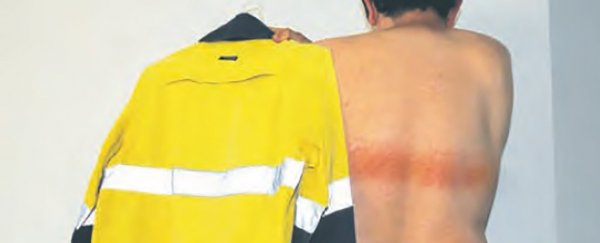The case of a 40-year-old Australian man has led to a warning about the use of high-visibility clothing in hot temperatures, after an overheating reflective stripe on the back of a vest caused first-degree burns.
The unfortunate individual turned up at his local emergency department complaining of a rash across his back. As the doctors noted, that rash perfectly matched the reflective stripe on the clothing the man had been wearing during the day.
As a field environmental engineer, the man regularly works outdoors, and reported that the high-vis tape did indeed become uncomfortably hot when in the sunshine.
While these types of vest do come with warnings about overheating, there's never been a report of anyone suffering burns from contact with the tape, which is typically made from very small glass beads or similar materials bound in transparent film.
"It could happen to other people as well, especially if they wear the same type of shirt and the same type of reflective tape, and especially if they work out in the Sun and the Sun shines directly onto the shirt," Ioana Vlad, the doctor who dealt with the patient, told the Australian Broadcasting Corporation (ABC).
The good news is that the injuries weren't serious, and were similar to the effects of sunburn – after a few days of discomfort, and treatment with aloe vera and painkillers, the man made a full recovery.
However, the unusual case has prompted calls for a change in the rules around outdoor workwear. The use of removable vests in sunny conditions, or a change in the design of the reflective tape on the shirts should be considered, Vlad says.
Under Australian law, it's down to employers to make sure their workers are protected on the job – and that includes protection from sunlight. The type of vest involved here has been cleared for use both in the daytime and nighttime.
Rare and unusual medical emergencies like this can be crucial for doctors and medical professionals in reducing risks for everyone else – anyone who hears of this case and wears a high-vis jacket outside during the day is now going to think twice about how hot it might be getting.
From the tale of the teenagers who completed a dangerous 1,000-squat challenge, to the story of a woman who mistook wasabi for avocado and ended up in hospital, these case studies are often more informative than being just a dramatic headline.
It also helps doctors to know what to expect next time – whether patients arrive at the emergency department crying tears of blood or with skin that's turning blue, every unusual incident can be instructive.
In this particular case, the solution was a simple one, even if it's something medical journals haven't documented before. Whenever you're outdoors, on the job or not, think twice about what you've got on your back.
Details of the case have been published in the Medical Journal of Australia.
